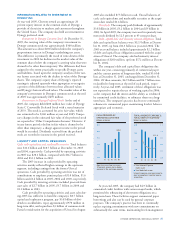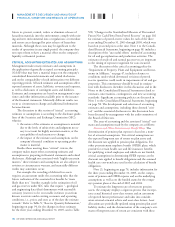Chevron 2005 Annual Report Download - page 44
Download and view the complete annual report
Please find page 44 of the 2005 Chevron annual report below. You can navigate through the pages in the report by either clicking on the pages listed below, or by using the keyword search tool below to find specific information within the annual report.
MANAGEMENT’S DISCUSSION AND ANALYSIS OF
FINANCIAL CONDITION AND RESULTS OF OPERATIONS
42 CHEVRON CORPORATION 2005 ANNUAL REPORT
derivative contracts by about $11 million. The same hypothet-
ical decrease in the prices of these commodities would result
in the same opposite effects on the fair values of the contracts.
The hypothetical effect on these contracts was estimated
by calculating the cash value of the contracts as the differ-
ence between the hypothetical and contract delivery prices
multiplied by the contract amounts.
Foreign Currency The company enters into forward
exchange contracts, generally with terms of 180 days or less,
to manage some of its foreign currency exposures. These expo-
sures include revenue and anticipated purchase transactions,
including foreign currency capital expenditures and lease com-
mitments forecasted to occur within 180 days. The forward
exchange contracts are recorded at fair value on the balance
sheet with resulting gains and losses refl ected in income.
The aggregate effect of a hypothetical 10 percent
increase in the value of the U.S. dollar at year-end 2005
would be a reduction in the fair value of the foreign exchange
contracts of approximately $70 million. The effect would
be the opposite for a hypothetical 10 percent decrease in the
year-end value of the U.S. dollar.
Interest Rates The company enters into interest rate
swaps as part of its overall strategy to manage the interest
rate risk on its debt. Under the terms of the swaps, net cash
settlements are based on the difference between fi xed-rate
and fl oating-rate interest amounts calculated by reference to
agreed notional principal amounts. Interest rate swaps related
to a portion of the company’s fi xed-rate debt are accounted
for as fair value hedges, whereas interest rate swaps relating to
a portion of the company’s fl oating-rate debt are recorded at
fair value on the balance sheet with resulting gains and losses
refl ected in income.
At year-end 2005, the weighted average maturity of
“receive fi xed” interest rate swaps was approximately 2 years.
There were no “receive fl oating” swaps outstanding at year
end. A hypothetical increase of 10 basis points in fi xed inter-
est rates would reduce the fair value of the “receive fi xed”
swaps by approximately $3 million.
For the fi nancial and derivative instruments discussed
above, there was not a material change in market risk
between 2005 and 2004.
The hypothetical variances used in this section were
selected for illustrative purposes only and do not represent
the company’s estimation of market changes. The actual
impact of future market changes could differ materially due
to factors discussed elsewhere in this report, including those
set forth under the heading “Risk Factors” in Part I, Item 1A
of the company’s 2005 Annual Report on Form 10-K.
TRANSACTIONS WITH RELATED PARTIES
Chevron enters into a number of business arrangements
with related parties, principally its equity affi liates. These
arrangements include long-term supply or offtake agree-
ments. Long-term purchase agreements are in place with the
company’s refi ning affi liate in Thailand. Refer to page 41 for
further discussion. Management believes the foregoing agree-
ments and others have been negotiated on terms consistent
with those that would have been negotiated with an unre-
lated party.
LITIGATION AND OTHER CONTINGENCIES
MTBE Chevron and many other companies in the petro-
leum industry have used methyl tertiary butyl ether (MTBE)
as a gasoline additive.
Chevron is a party to more than 70 lawsuits and claims,
the majority of which involve numerous other petroleum
marketers and refi ners, related to the use of MTBE in cer-
tain oxygenated gasolines and the alleged seepage of MTBE
into groundwater. Resolution of these actions may ultimately
require the company to correct or ameliorate the alleged
effects on the environment of prior release of MTBE by the
company or other parties. Additional lawsuits and claims
related to the use of MTBE, including personal-injury
claims, may be fi led in the future.
The company’s ultimate exposure related to these lawsuits
and claims is not currently determinable, but could be material
to net income in any one period. The company does not use
MTBE in the manufacture of gasoline in the United States.
Environmental The company is subject to loss contingen-
cies pursuant to environmental laws and regulations that in
the future may require the company to take action to correct
or ameliorate the effects on the environment of prior release of
chemicals or petroleum substances, including MTBE, by the
company or other parties. Such contingencies may exist for
various sites including, but not limited to federal Superfund
sites and analogous sites under state laws, refi neries, crude oil
fi elds, service stations, terminals, and land development areas,
whether operating, closed or divested.
The following table displays the annual changes to the
company’s before-tax environmental remediation reserves,
including those for federal Superfund sites and analogous
sites under state laws.
Millions of dollars 2005 2004 2003
Balance at January 1 $ 1,047 $ 1,149 $ 1,090
Net Additions 731 155 296
Expenditures (309) (257) (237)
Balance at December 31 $ 1,469 $ 1,047 $ 1,149
Included in the additions for 2005 were liabilities
assumed in connection with the acquisition of Unocal. These
liabilities relate primarily to sites that had been divested or
closed by Unocal prior to its acquisition by Chevron, includ-
























